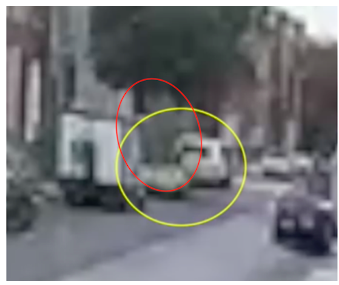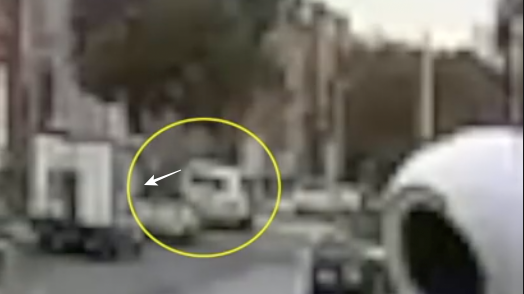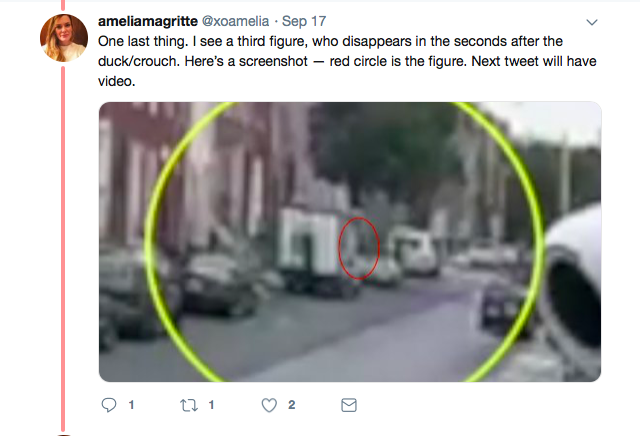
TRIGGER WARNING: This article includes video and audio of someone’s last moments
What does the evidence actually reveal, and why isn’t it being talked about?
The Independent Review Board (IRB) report on the death of Baltimore Police Detective Sean Suiter describes what happens at exactly 4:36:10pm on the video and the audio. It concludes that these two things could not have happened at the same time, so the audio and video timestamps must be out-of-sync.
By the time the IRB was contracted to investigate the case, there were two prevailing theories. Both involved Suiter running into a vacant lot before shots were fired. In one theory, he shot himself; in the other, his gun was taken by a stranger and used against him.
The IRB seemed to have accepted that one of these theories had to be true instead of following what the evidence revealed. Its suicide conclusion is based on eliminating certain homicide possibilities without considering all of them.
This article proposes that instead of starting from a theory, we start from the evidence. Let’s accept that the video and audio of 4:36:10pm happened as the records indicated, simultaneously.
What happened at 4:36:10pm on the video?
The IRB report described the 4:36:10pm moment on the video as follows, largely relying on the recollections of Suiter’s partner that day, Detective David Bomenka:
At 4:36:10 p.m., Suiter ran towards the vacant lot and out of view of the Bennett Place Video and Detective Bomenka. As Detective Suiter disappeared from view, Detective Bomenka observed Suiter beginning to unholster his weapon with his right hand. Just prior to that, Suiter waved at Bomenka; the purpose of this gesture was unclear. Bomenka interpreted the wave to signify that something was happening in the vacant lot.
Here is that moment on the close-up of the surveillance video provided by the Baltimore Police Department (BPD), which is quite blurry. Suiter is the black figure standing and then moving behind the white van, in the yellow circle (which was inserted by BPD):
The last article in this series discussed how to read the timestamps on this video. It also discussed a challenge in viewing it. Once Suiter moves just to the left of the van, he is much harder to make out. There is an obviously smudged area, a “dead zone” (circled in red in the picture below):

There is actually unreported activity in the smudged area. It is much easier to see when the video is enhanced, as first indicated by crime journalist Amelia McDonell-Parry. Here is the 4:36:10pm moment in played back in a high-contrast, slo-motion close-up:
At the moment at which the IRB says that Suiter “ran towards the vacant lot and out of view,” he actually bent forward suddenly – “to half his height,” as McDonell-Parry wrote. He does fall out of view on screen, behind the parked car.
Here is a video screen grab of the cursor moving slowly back and forth over that moment. Follow the top of Suiter’s head:
In BPD’s version of the video, it appears that Suiter runs after he falls. Actually, that is not Suiter. In the enhanced close-up of the video, you can see a figure that looks like a black shadow, coming from further back in the dead zone, near the cross street, just after Suiter falls. The path of the running figure is indicated by the white arrow:

Now, watch the close-up, slow-motion video again, looking for the running figure. This time, the video is provided on loop:
From a distance and at regular speed, the running figure merges into Suiter’s collapse, giving the impression that Suiter is seen running into the lot. The running figure is also not Bomenka, who is the white figure to his left; more on that shortly. The smudge over the dead zone greatly obscures what is going on.
McDonell-Parry also identified this figure, which appears to the left of the van, facing Suiter when he collapses:

Like the running figure, this figure has a human-like shape, it enters and leaves the frame, and it moves.
What happens at 4:36:10pm on the audio?
Meanwhile, also at exactly 4:36:10pm, dispatch audio reports say that Suiter made his final call, as reported by the IRB. Here is that audio, provided by BPD:
The IRB had an interesting take on this audio:
The radio transmitted an unintelligible sound. Some law enforcement personnel who know Suiter believe it was his voice. A loud sound then occurs, which may or may not be a gunshot. The radio signal then went dead. This radio transmission occurred at 4:36:10 p.m. according to transmission records, the same moment the Bennett Place Video shows Suiter running into the lot. The video and radio timing mechanisms, however, are not synchronized to the second.
Without pointing to any justification, the IRB states that the audio and video are out of sync. The IRB’s entire take on the audio evidence is odd. The report confirms that the call came from Suiter’s radio. It confirms that Suiter was shot around that time. But the sound on the radio “may or may not be a gunshot”?
Later, the report adds, “If there is one thing that is ‘clear’ about this transmission, it is that nothing in this transmission is clear.” If there is one that is clear, it is that the IRB did not want to deal with the significance of this radio transmission. It complicated its entire theory.
Putting the audio and video together
Here is the close-up video overplayed with the full audio call, synched up as closely as possible to 4:36:10pm on the video. As a reminder, we don’t have the audio for anything before or after, only the sounds that Suiter recorded:
And here it is in close-up, slo-motion (where the difference between Suiter and the running figure is clearer):
The conclusion proposed here is that someone shot at Suiter just before 4:36:10pm, causing him suddenly to either duck down or collapse. The other possibility could be that someone stepped forward with a gun, so he ducked. His collapse is quite sudden though.
He then initiated a radio call that captured another shot fired, by someone. He was fatally injured before he could record any other shots.
This conclusion could explain several things:
- It could explain Suiter’s very sudden falling motion out of view. Shots were fired in his direction.
- It could explain why, just as Suiter suddenly fell, there were shots on the radio.
- It could explain why Suiter was said to be found still gripping his radio in his hand.
Earlier in this series, I questioned the evidence that Suiter was still gripping his radio when he was found dying. I had spoken with four different forensic and medical experts who said that someone who shot himself in the head, from an upright position, would lose the ability to grip with his hand. If Suiter was already ducking bullets or shot at that moment, then it is believable that the radio would still be in his hand. He could’ve made the call from a prone or falling position.
Who was shooting at Suiter? Where was Bomenka?
Bomenka is a pale white figure in the video, as identified by the IRB. Here is BPD’s video of Suiter walking with Bomenka before the shooting. Bomenka is visible when they separate:
But when Bomenka is in the dead zone, before and after Suiter’s shooting, he is truly ghost-like. Here he is minutes before the shooting, standing near the corner of the building at Schroeder:

You can see him better in motion:
At 4:36:10pm, Bomenka told investigators that he was standing at that corner, watching Suiter wave at him then run into the lot. On the video of the shooting, he only appears clearly there seconds before and after Suiter collapses. The video gets especially blurry during the collapse, just as the dark figure runs in front of Bomenka.
If Bomenka was at that corner at 4:36:10pm, he would have had a clear view of Suiter’s collapse at 4:36:10pm. He told the investigators that he did not see anything. Bomenka also denied that he saw other people at the scene when Suiter was shot. As I wrote in the Baltimore Brew, there is another video of the scene that was confiscated and has not been released. It could provide clarity.
It’s not clear from the video exactly who was shooting at Suiter around 4:36:10pm. Bomenka appears to have been 60 to 70 feet away just before and after Suiter’s collapse. This article’s conclusion is just that someone fired at him. That said, the close-up, slo-motion, synched up video-plus-audio is suggestive of a more specific story. Follow the dark figures. Here it is, once again:
Could the IRB be right that the video and audio are off-sync?
The IRB only goes so far as to suggest that the audio and video are off-sync enough to make its suicide theory work but not enough to disrupt the rest of its narrative. The IRB’s version of events would put the video earlier than the audio by around ten to twenty seconds.
There are valid reasons to question the video and audio timestamps. A footnote in the IRB report states that BPD determined that the timestamp shown on the video screen is off by 11 hours and 4 minutes. A flat 11 hours would make more sense, given daylight savings time.
However, the video’s timestamp, as recalibrated by BPD, does line up with other evidence. It lines up with the timestamps on stills from body-worn camera (BWC) footage of responders, as included in the IRB report. As discussed in the previous article in this series, a patrol officer’s car pulls up outside of the vacant lot just seconds before his BWC camera shows him approaching the lot. If the surveillance video were ten or more seconds earlier than what BPD determined, then the BWC would also have to be off-sync by that much.
The surveillance video also lines up with certain dispatch calls, as downloaded last year from Broadcastify and the public scanner. So there is no independent reason to question BPD’s timestamp for the surveillance video.
But wasn’t Suiter shot with his own weapon?
It has been a common assumption that Suiter was shot with his own weapon. It has also been a common assumption that no other weapons were used at the scene. Then-Commissioner Kevin Davis announced these findings one week after Suiter’s fatal shooting, but the evidence does not offer conclusive proof.
The third article in this series consulted with several ballistics experts who called into question these early determinations. A process called “shooting scene reconstruction” was used to match Suiter’s gun to a bullet discovered at the scene, which is not an exact science.
That article additionally deconstructs the alleged discovery of the fatal bullet. After federal and local agents had combed the plot for four days, somehow, a team of BPD investigators knew exactly where to dig a small hole for the fatal bullet while WBAL’s cameras were rolling. (The IRB reports states that investigators knew where to look because of the autopsy’s assessment of gunshot trajectory. Suiter was said to be shot in the right side of his head, so it’s unclear how the investigators landed exactly on that location.)
The IRB seemed to have agreed that the ballistics evidence was insufficient to link Suiter’s gun to his death, so it conducted an additional forensic test. Suiter’s gun was found to have his DNA in the barrel, the report noted:
The most plausible explanation for the presence of Suiter’s DNA inside of the barrel of his gun is that blood from Suiter’s head was expelled into the barrel milliseconds after the fatal contact wound shot. If there had been pre- existing DNA of Suiter’s inside the barrel, it was likely expelled or destroyed by the firing of three grooved bullets through a tight barrel, coupled with the heat and gases produced by the firing.
There haven’t been many scientific tests to conclusively prove that DNA inside of a barrel can match guns to victims, but one of them clearly states that DNA will persist in the barrel of a gun after shots are fired in the majority of cases. Indeed, this study appeared at the top of the google results for “DNA found in the barrel of a gun.”
The IRB ran an additional forensic test to prove that the DNA in the barrel could have only come from Suiter’s gunshot wound:
The forensics lab tested two service weapons, which had been used by two officers for several years. These officers were responsible for cleaning their own guns pursuant to department protocol, but they did not clean the guns immediately before the test. The forensic lab fired three shots from each weapon (the same number of shots that were fired from Suiter’s service weapon). There was no DNA profile developed after swabbing the barrels of these weapons. Specifically, no DNA of either of the officers was found in the barrels of their service weapons.
The forensic lab concluded that Suiter’s DNA found in the barrel of his service weapon almost certainly had to come from blood exiting his head after the fatal shot was fired.
An ad hoc test on two guns hardly meets the “Daubert Standard” for a credible forensic science with a standard potential rate of error.
Even if the IRB’s test were conclusive, any determination about the ballistics in this case also has to take into account the poor handling of the evidence and crime scene. As the IRB report notes, Suiter’s gun was put in the trunk of a patrol car, unsecured, before it could be photographed at the scene by the Crime Unit (CU). There was no chain of evidence on its handling until it was brought to the Evidence Control Unit.
Also, the surveillance videos shows Bomenka visiting Suiter’s dying body almost two minutes before any other officers responded to the scene, as discussed in the previous article. The IRB carefully avoided mentioning this moment in its report. Bomenka even blocked a car from passing by the vacant lot. This is more suspicious if we consider the possibility of one or more other people at the scene.
If all of that doesn’t complicate things enough, local journalist Media WatchDog pointed out where CU ended up marking Suiter’s body, after he was taken away from the scene to the hospital. The markings are nowhere near where Suiter’s body appears on BWC.
All of this is to say that the presence of DNA in the barrel of Suiter’s gun is suggestive but not conclusive that Suiter was shot with his own weapon, and the poor maintenance of evidence and the crime scene makes the ballistics-related evidence unreliable.
Moreover, the conclusion outlined in this article does not preclude the possibility that Suiter’s gun was used on him at some point. It just proposes that the first shots fired didn’t come from his gun, unless someone else had it in their possession. (Contrary to media reports from earlier this year, he is never shown holding his gun on the video. It only shows up under him when patrol officers arrive.)
Could this conclusion be compatible with the homicide-by-stranger theory?
Theoretically, if we believe that the audio and video timestamps documented by BPD are accurate, some parts of the stranger theory could still be true. Suiter and Bomenka could have been staking out a drug dealer who surprised and shot at Suiter.
The tide has been shifting back from suicide to homicide-by-stranger in media lately, with new information putting a dent in the IRB’s suicide conclusion. This shift has been aided by WMAR news, Kevin Davis, the team supporting the Suiter family, and possibly someone in the State’s Attorney’s Office.
Many of the BPD officials who pushed the suicide theory in leaks to media have left the department since the GTTF trials earlier this year. They no longer have center stage. Even WBAL’s Jayne Miller, who repeatedly and prominently reported during the last year that the evidence “leans to” suicide, has recently been suggesting otherwise.
The biggest problem with the homicide-by-stranger theory is that it fails to explain the obvious and extensive cover-up around this case, since day one. If Suiter truly died in the line-of-duty, there would be nothing to hide. I have pointed to possible cover-up in the previous articles in this series, as well as here and here. It includes the following:
- Bomenka’s refusal to share any information at all with investigators on the scene, as well as his changing stories over the interviews that followed.
- The omission from public records and the IRB report of Bomenka’s 911 call, on which a dispatch report says he claimed to be “off-duty.”
- The other missing audio and video evidence.
- The video evidence of least one other person at the shooting scene, unaccounted for.
- The indications that the video was manipulated to hide that evidence.
- The highly staged and suspicious bullet discovery.
- Davis’ numerous efforts to direct the narrative aggressively away from what Suiter had scheduled the next day – a meeting with federal prosectors and grand jury testimony in a Gun Trace Task Force related case – despite the feds’ repeated implications that it was important.
- The leaking of false information by high-ranking officials to media about the video, Suiter’s state of mind, and more.
- The IRB report’s dancing around Bomenka’s activities, including his early visit to the crime scene.
- The IRB report’s presentation of second- or third-hand information as fact, such as medical records.
- And more.
The number of coincidences and excuses needed to explain away all of these issues would be extraordinary.
The homicide-by-stranger theory might be the best outcome to protect the Suiter family in the long-term. It may not be the best outcome to protect Baltimore, if it allows a culture of cover-up and corruption to continue unchecked.
Conclusion
It’s been over a year since Suiter was shot dead. Rather than work towards peeling away the onion, officials and media continue to add confusing layers.
WMAR’s recent release of a December 2017 police interview with a confidential (no longer) informant is just the latest example. The CI’s second-hand account of Suiter’s death-by-stranger is hardly air-tight. Still, media ran with it, unconcerned about the CI’s safety. As usual, local outlets failed to approach the information suspiciously and ask pertinent questions: Who was doing the interview from homicide? Did they have any conflicts of interest, as it may seem? What can we learn from the CI’s history with GTTF officers? Why is this coming out now?
In the meantime, this series ends without certainty about who killed Suiter but with this much clarity:
- The audio and video evidence strongly suggests that Suiter’s death was a homicide.
- The evidence also suggests that his homicide has been aggressively covered up at many levels for more than a year.
- The evidence of a cover-up makes it unlikely to have been a routine killing in the line of duty, unrelated to his scheduled conversation with federal investigators the next day.
This series is complete. But ongoing articles and discussions about this case and related topics will continue at The Suiter Files, a website dedicated to this case and other issues in Baltimore and policing.
Amelia McDonell-Parry contributed to this article.





















 More news and opinions than at a Shabbat dinner, right in your inbox.
More news and opinions than at a Shabbat dinner, right in your inbox.